The following optional sound ports and inlay work are not available for individual sale and are only available on McKnight Guitars.
When you play a standard acoustic guitar, you never hear the true sound that the guitar is producing. Why? Because what you hear is reflected sound. Have you asked someone to play a guitar for you, so you can hear it? Maybe you have played a guitar in a corner, or close to a wall, so you can hear it more clearly. Do you find yourself leaning over the side of the guitar, or angling the guitar upward, so your ear is more in line with the sound hole? If so, read on …
Now, with the benefit of a McKnight Sound Port, you can hear the true sound your guitar is producing. The sound port directs a portion of the guitars true sound to the player. The results are truly amazing! It is like having your very own personal sound monitor built into your McKnight Guitar.
Blindfold tests prove that there is absolutely no loss of energy with a sound port. In fact, the results are quite the opposite. There is a discernable gain in sound hole projection, as well as a 360 degree sound gain around the player.
Call McKnight Guitars today for more information on ordering your custom built guitar with the new, innovative Sound Port.
9/23/2006 – We just finished some preliminary testing, read on –
I was reading a thread on the internet recently and someone quoted me that “sound ports increased frontal projection”. However, the poster mentioned that they could not believe my statement because I had no scientific data to back up my statement. Well, they were correct because I did not have any data to offer scientific proof other than the gray matter residing on top of my shoulders. This piqued my interest and motivated me to set out to run some experiments to prove or disprove my gut instincts.
I borrowed a Metrosonics db307 Noise Dosimeter from a local lab and set out to run a few DOE’s. I enlisted the help of a local musician to [consistently] strum open strings (without a pic) as I measured the decibel levels at different locations around two guitars, at different distances. The room we used is our “Studio Loft” located above our work shop. The room is 16 feet wide x 26 feet long with 7 foot ceilings. The room has hardwood floors, textured drywall on the ceiling and walls. A center rug, numerous bass traps and acoustic panels are strategically placed around the room and in all corners to control reflective noise.
The following should also be prefaced by first saying this was not a lab quality double blind test nor were mechanical fixtures used to eliminate the human element from the tests. I only had a few hours availble to borrow the meter so I did the best that I could with what little time I had. We used two guitars for this experiment: a Honduras Mahogany / Adi MacNaught with an oval shaped sound port, on the upper bout side, which shall henceforth be referred to as guitar A, and a Cuban Mahogany / Cedar Highlander with a Luckenbooth sound port which shall be referred to as guitar B.
I have stated numerous times that there is no loss of projection and actually a small but discernable gain in forward projection and also an increase in 360* projection. Well stay tuned to see how accurate my gray matter is to the high tech lab Dosimeter.
Guitar A was first measured with the sound port closed with a [pink] sponge and the Dosimeter microphone was placed 6″ in front of the sound hole. Brad strummed the guitar in 4/4 time until we had a relatively steady display on the Dosimeter and then I snapped a picture to capture the data. Three pictures were taken to record three separate measurements at each position and then the measurements were compared on the digital pictures for accuracy. After we reviewed the pictures we found that the measurements had a total range of no more than .2 db for all the tests that we ran.
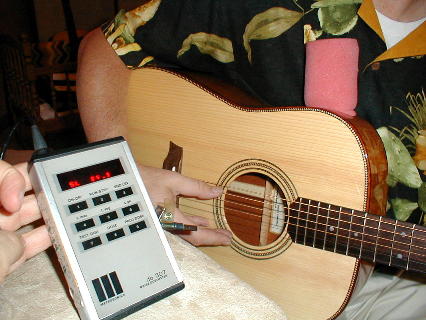
This position measured 84.6 db with the side soundport closed.
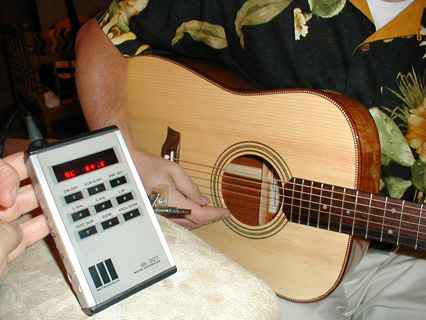
I removed the sponge from the oval sound port and measured the volume again and we recorded 94.8 db. A significant increase of 10.2 db at the main sound hole.
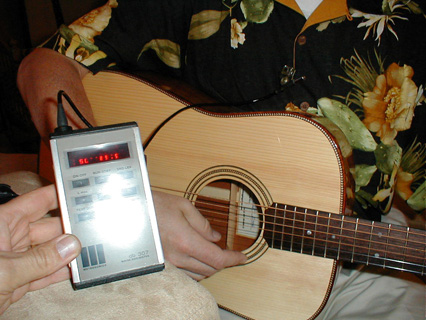
Next the mic was moved 6″ above the sound port and we measured the sound level the player normally hears with NO sound port and it measured 71.1 db. We then uncovered the port and measured an amazing 89.5 db emitted from the side sound port. That is an 18.4 db gain at the side sound port.

Next we measured guitar B, first at the main sound hole in the top, with the port closed and we recorded 88.6 db.
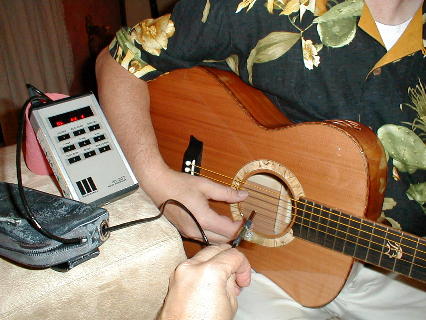
The port was then uncovered and we measured 89.7 db or a gain of 1.1 db.
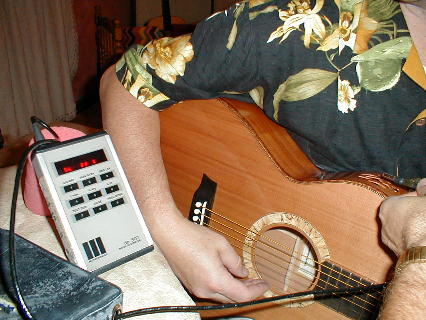
We then measured the sound at the port with the port closed to simulate what a player would hear without a side sound port and measured 74.3 db. The port was then uncovered and we measured an astounding 98.6 db or a whopping 24.3 db gain!
This was shocking since this guitar had the Luckenbooth port and I thought the volume might actually be less than an oval or pic shape port. Hmmm, I was surprised by the data on that one.
Next I had Brad set in the middle of our studio sound room and continue his 4/4 strumming on guitar B while the Luckenbooth port was left open. I measured the sound volume level at four different locations, six feet away from him. The first measurement was taken directly in front of the sound hole and it measured 72 db. I walked towards the neck and measured 68 db. Next I stood directly behind him and measured 70 db and the last measurement was recorded at the tail end of the guitar and this measurement was 74 db which was louder than the frontal measurement. This was a bit puzzling so I had him cover the port and the db level dropped to 69 db. We concluded that this was the area that produced the most stereo effect of the sound hole combined with the side sound port because this was the direction the port was facing towards.
Since we proved that there was a quantifiable and measurable gain in frontal projection on both guitars with the side sound port open I wanted to find out what effect there was at longer distances. We measured 10 feet from the sound hole and measured 82.1 and 83.5 with the port closed and then open. Next we measured the volume at 20 feet and recorded 68.3 and 69.9 db with the port closed and then opened.
So there you have it folks, for what it its worth ??? I am not a scientist and I am sure someone will challenge my results but this is the best that this ole’ boy can do. Now, back to makin’ sawdust.